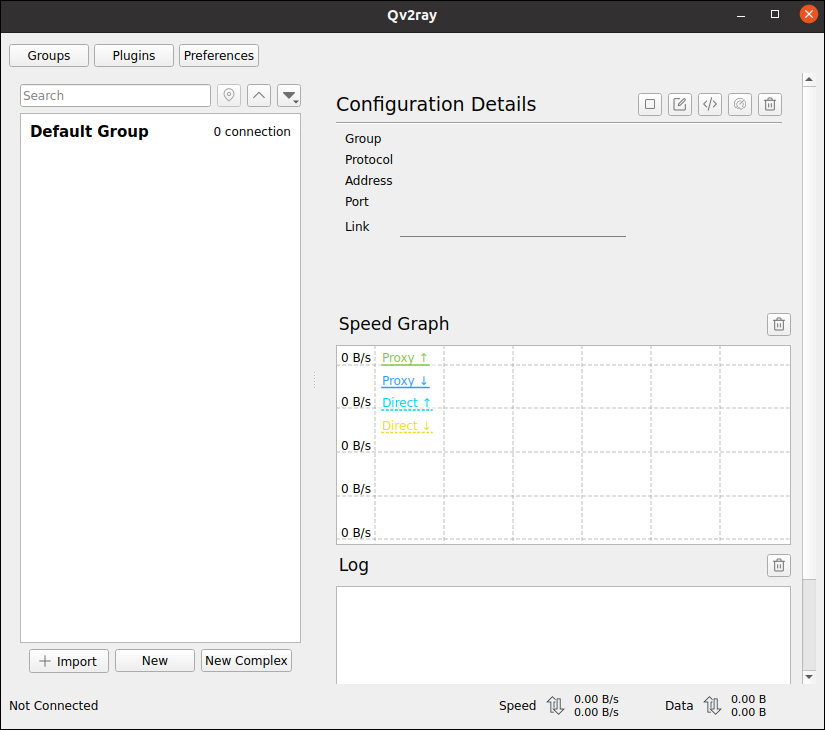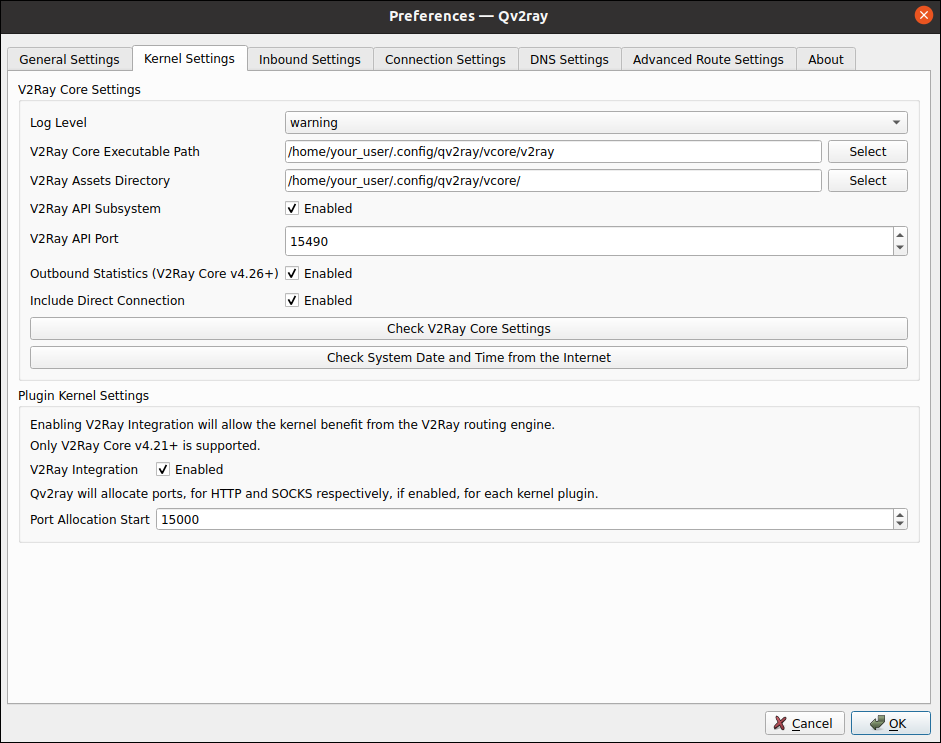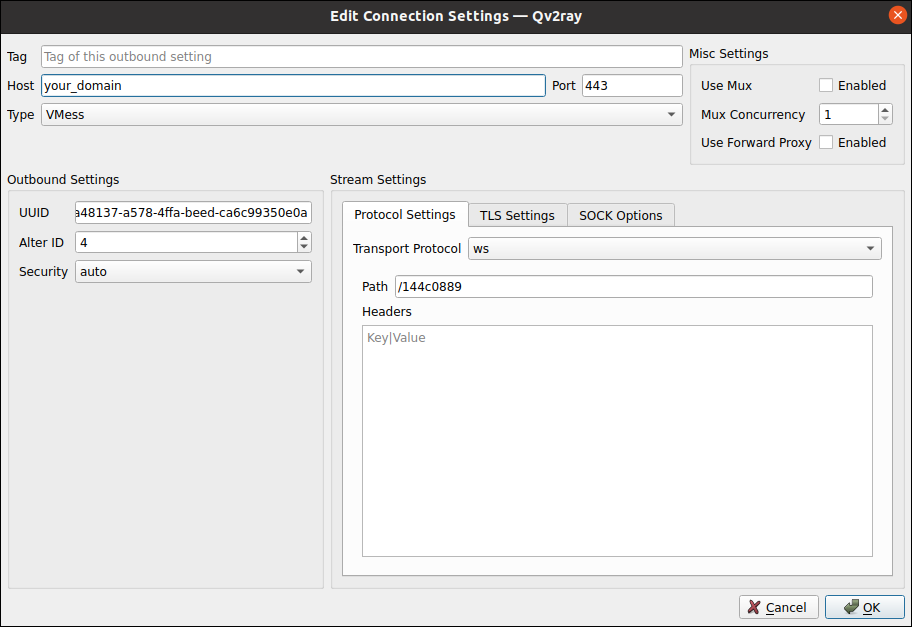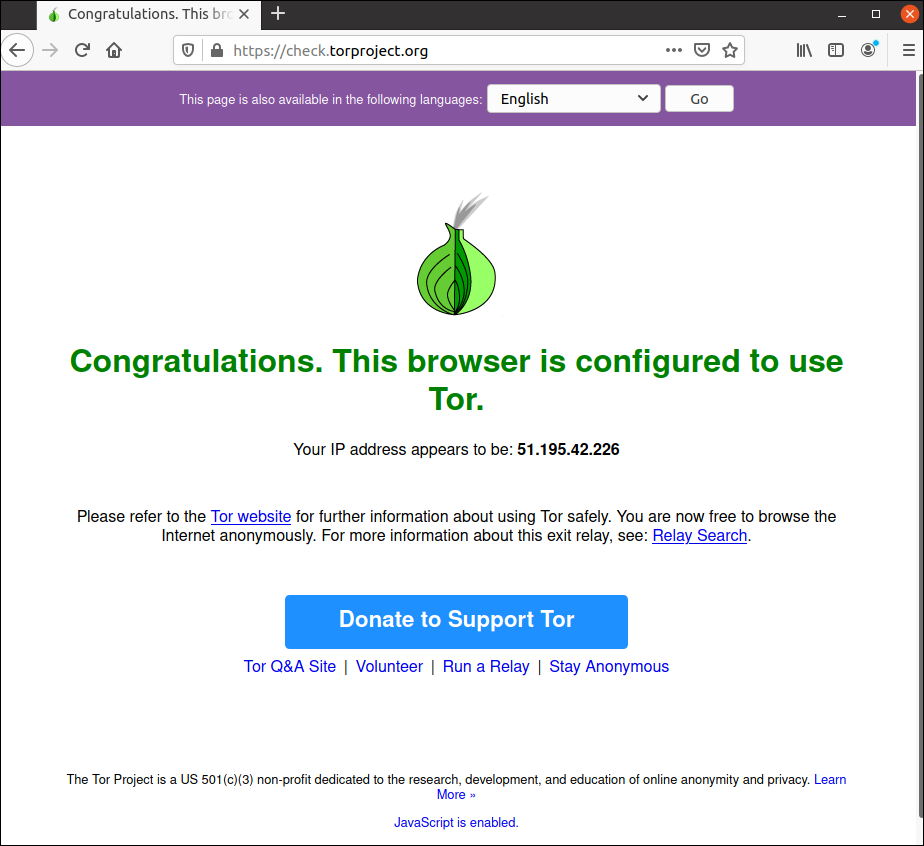Introduction
Are you in a country where the Tor Project website is blocked, the Tor protocol is blocked, and Tor bridges are also blocked?
If so, this post offers a last resort for situations when all other methods of reaching Tor have failed. You’ll learn how to create a Tor on-ramp on an Ubuntu 20.04 server located outside your country. With this method you can bypass censorship and connect to the Tor network from your existing browser.
By following along, you’ll see how to create an Nginx camouflage web server and a hidden V2Ray server. The V2Ray server will relay your traffic to and from the Tor network. As a final step, you’ll see how to test your Tor on-ramp using the Qv2ray graphical user interface.
At the end of this tutorial, you’ll have a working and tested Tor on-ramp.
Prerequisites
Before you begin this tutorial, you will need:
- A virtual private server (VPS) running Ubuntu 20.04. You can rent servers from providers such as Google Cloud or Vultr. This server needs to be located in a country that does not block Tor.
- Your own domain name, which may be free or paid.
- A DNS type
Arecord pointing from the fully qualified domain name of your server to the server’s IP address. Usually you set up the DNS record at your domain name registrar. However, WebSocket will also work with a server proxied via a Content Distribution Network such as Cloudflare.
Step 1 — Logging In as Root
SSH into your server. On Linux and macOS, you can use the terminal command ssh to reach your server. On Windows, you can either use PowerShell or a graphical user interface (GUI) such as PuTTY or XSHELL.
If you’re not logged in as root, then become root as follows. If you don’t already know the root password, then set it by issuing the command:
sudo passwd root
The sudo command allows non-root users to issue root commands. The passwd command allows you to set the password for yourself or another user, which in this case is the user named root.
You are prompted to enter your own password:
[sudo] password for amy:
Enter your own (non-root) password.
You are then prompted to enter a new password for the user root:
New password:
Choose and enter the new password for root.
You are prompted to confirm the new password by retyping it:
Retype new password:
Enter the same new password for root.
If all is well, you will receive a feedback message:
passwd: password updated successfully
Now you know the root password, become root:
su -
The su command (short for switch user) allows you to switch to another user id, so that you can run commands with that user’s privileges. Since no specific user is named, you will by default switch to the user root. The hyphen (-) means create a new login environment for the new user, which will be completely separate from your existing login environment.
You are prompted to enter the password for root that you set a few moments ago:
Password:
Enter the root password.
You will notice that your command prompt changes from a dollar sign to a hash sign:
#
This is a reminder that your are logged in as root. Now that you are root, you do not need to prefix privileged commands with sudo.
Update your package lists, and upgrade all your packages to the latest version:
apt update && apt upgrade -y
You will see package upgrade messages in your terminal.
Step 2 — Enabling the Firewall (Optional)
We recommend that you protect your server and especially port 22 (the SSH port) by installing a firewall. In this tutorial, you’ll install and configure the uncomplicated firewall (ufw).
On many Ubuntu systems, ufw is already installed. Check that ufw is installed on your system:
apt list ufw
You should see a message:
ufw/focal,now 0.36-6 all [installed]
If you do not see the message stating that ufw is already installed, then install the software package now:
apt install ufw
Now you’ll set up the firewall. If you can guarantee that you will always SSH into your server from a single IP address, then limit SSH access to just that single address. For example, if your IP address is 12.12.12.12, then issue the command:
ufw allow from 12.12.12.12/32 to any port 22 proto tcp
When you execute that command, you will see a message:
Rule added
If limiting access to a single IP address is not possible, but you can guarantee you will always connect from a known IP address range, then limit SSH access to just that range. For example, if you are in an office which always uses the IP address range 12.12.12.0/24, then issue the command:
ufw allow from 12.12.12.0/24 to any port 22 proto tcp
If limiting access to an IP address range is not possible, then you will have to open the SSH port for access from the entire world:
ufw allow ssh
In any case, we recommend that you further protect port 22 by using SSH key authentication in preference to password authentication. SSH key pair generation and upload to your server are out of scope for this tutorial. You can find tutorials on this subject on the web.
Open ports 80 (the HTTP port) and 443 (the HTTPS port). These will be used for the Nginx camouflage web server:
ufw allow http
ufw allow https
Enable UFW:
ufw enable
You will see a warning message:
Command may disrupt existing ssh connections. Proceed with operation (y|n)?
Type Y and press ENTER to confirm that you wish to enable ufw. You will see a message:
Firewall is active and enabled on system startup
Check the status of your firewall:
ufw status
You will see a firewall status display that looks like the following:
Status: active
To Action From
-- ------ ----
22/tcp ALLOW 12.12.12.0/24
80/tcp ALLOW Anywhere
443/tcp ALLOW Anywhere
80/tcp (v6) ALLOW Anywhere (v6)
443/tcp (v6) ALLOW Anywhere (v6)
If your VPS provider implements the concept of security groups, you will also need to open your security group assignments for ports 22, 80, and 443 in their control panel.
Step 3 — Creating a Camouflage Website
Now you’ll install Nginx and obtain an SSL certificate. The purpose of Nginx is to camouflage your V2Ray server.
Install the Nginx web server package:
apt install nginx -y
If Nginx was not already installed, you will see the package installation messages.
Edit the default virtual host configuration file, /etc/nginx/sites-available/default:
nano /etc/nginx/sites-available/default
Find the line containing server_name _;. Change it so that it refers to the fully qualified domain name of your server:
server_name your_domain;
Write the file out to disk, and exit the editor.
Restart Nginx with your revised change configuration:
systemctl restart nginx
You will use snap to install certbot, the Let’s Encrypt client. First install the core snap:
snap install core
After the snap is installed, you will see a confirmation message:
core 16-2.48.2.1 from Canonical✓ installed
Get the core snap up to date if necessary:
snap refresh core
Since core is already up to date, you should see a message:
snap "core" has no updates available
Now use snap to install the certbot client for Let’s Encrypt:
snap install --classic certbot
The --classic option means that certbot will not be confined to a restricted environment in the same way as normal snaps are.
The installation ends with a message:
certbot 1.12.0 from Certbot Project (certbot-eff✓) installed
The snap executable for certbot is in the directory /snap/bin, which should be in your execution PATH. If you want to make extra sure that certbot is executable, then also create a symbolic link to certbot in your /usr/bin directory, which should definitely be in your PATH:
ln -s /snap/bin/certbot /usr/bin/certbot
The symbolic link /usr/bin/certbot now points to the actual executable at /snap/bin/certbot.
Now you can invoke certbot to obtain your SSL certificate from the Let’s Encrypt project:
certbot --nginx
The --nginx option tells certbot that Nginx is already running and available for use by certbot to validate your request.
You are asked to enter your email address in case Let’s Encrypt has some urgent notices to send you:
Enter email address (used for urgent renewal and security notices)
(Enter 'c' to cancel):
Type your email address, and press ENTER.
You are asked to read and agree to the terms of service:
- - - - - - - - - - - - - - - - - - - - - - - - - - - - - - - - - - - - - - - -
Please read the Terms of Service at
https://letsencrypt.org/documents/LE-SA-v1.2-November-15-2017.pdf. You must
agree in order to register with the ACME server. Do you agree?
- - - - - - - - - - - - - - - - - - - - - - - - - - - - - - - - - - - - - - - -
(Y)es/(N)o:
Type Y and press ENTER.
You are asked if you want to share your email address with the Electronic Frontier Foundation:
- - - - - - - - - - - - - - - - - - - - - - - - - - - - - - - - - - - - - - - -
Would you be willing, once your first certificate is successfully issued, to
share your email address with the Electronic Frontier Foundation, a founding
partner of the Let's Encrypt project and the non-profit organization that
develops Certbot? We'd like to send you email about our work encrypting the web,
EFF news, campaigns, and ways to support digital freedom.
- - - - - - - - - - - - - - - - - - - - - - - - - - - - - - - - - - - - - - - -
(Y)es/(N)o:
Type Y or N as you prefer, and press ENTER.
You are asked to confirm which fully qualified domain name(s) you want an SSL certificate for:
Which names would you like to activate HTTPS for?
- - - - - - - - - - - - - - - - - - - - - - - - - - - - - - - - - - - - - - - -
1: your_domain
- - - - - - - - - - - - - - - - - - - - - - - - - - - - - - - - - - - - - - - -
Select the appropriate numbers separated by commas and/or spaces, or leave input
blank to select all options shown (Enter 'c' to cancel):
Type the number of your server’s fully qualified domain name, which would be 1 in our example, and press ENTER.
The utility performs “challenges” to confirm that your domain name choice is legitimate. If all is well, you should see some closing messages. Certbot amends your site definition to supplement the existing HTTP server with an HTTPS server:
Redirecting all traffic on port 80 to ssl in /etc/nginx/sites-enabled/default
- - - - - - - - - - - - - - - - - - - - - - - - - - - - - - - - - - - - - - - -
Congratulations! You have successfully enabled https://your_domain
- - - - - - - - - - - - - - - - - - - - - - - - - - - - - - - - - - - - - - - -
You will then see some notes on the certificate and key locations:
- Congratulations! Your certificate and chain have been saved at:
/etc/letsencrypt/live/your_domain/fullchain.pem
Your key file has been saved at:
/etc/letsencrypt/live/your_domain/privkey.pem
Your certificate will expire on 2021-05-15. To obtain a new or
tweaked version of this certificate in the future, simply run
certbot again. To non-interactively renew *all* of your
certificates, run "certbot renew"
- If you like Certbot, please consider supporting our work by:
Donating to ISRG / Let's Encrypt: https://letsencrypt.org/donate
Donating to EFF: https://eff.org/donate-le
Finally, do a dry run to check that the renewal process will work in 90 days' time:
certbot renew --dry-run
This should end with a message:
- - - - - - - - - - - - - - - - - - - - - - - - - - - - - - - - - - - - - - - -
Congratulations, all simulated renewals succeeded:
/etc/letsencrypt/live/your_domain/fullchain.pem (success)
- - - - - - - - - - - - - - - - - - - - - - - - - - - - - - - - - - - - - - - -
Step 4 — Installing Tor
Install the Tor package:
apt install tor -y
Tor begins running right away. It listens for SOCKS connections on port 9050.
Step 5 — Generating Universally Unique Id and Path
In this step, you’ll generate a universally unique id (UUID) that will act as a password for your V2Ray server. You’ll also generate a random path to which requests are sent in order to access V2Ray instead of Nginx.
Install the UUID package:
apt install uuid -y
You will see the package installation messages.
Once the install is done, generate a UUID:
uuid -v 4
The option -v 4 causes the package to create a version 4 UUID. Version 4 UUIDs are completely random and not related to the system time. Since a UUID is composed of 128 random bits, the chances are no one else will ever generate the same UUID.
You will see the sample result below used in the rest of this tutorial:
e2a48137-a578-4ffa-beed-ca6c99350e0a
Also generate a random 8-character path name:
openssl rand -hex 4
The openssl rand function generates a pseudo-random number. It will have 4 bytes, which when expressed with the -hex option gives 8 hexadecimal characters.
You will see the sample result below used in the rest of this tutorial:
144c0889
Step 6 — Installing V2Ray
Now you are ready for the install of V2Ray.
Download the V2Ray installation script:
wget --no-check-certificate https://raw.githubusercontent.com/v2fly/fhs-install-v2ray/master/install-release.sh
You will see a message saying the script has been saved:
2021-02-15 13:27:04 (38.3 MB/s) - ‘install-release.sh’ saved [21613/21613]
Run the V2Ray installation script:
bash install-release.sh
The script can take a minute or so to run. The install ends with a message:
Please execute the command: systemctl enable v2ray; systemctl start v2ray
You will do these steps in a moment, after you have configured V2Ray.
Step 7 — Configuring V2Ray and Nginx
In this step, you’ll configure V2Ray so that it accepts WebSocket traffic on port 10000.
Edit the V2Ray configuration file, /usr/local/etc/v2ray/config.json:
nano /usr/local/etc/v2ray/config.json
At first, the file contains only opening and closing curly braces:
{}
Delete the initial content.
Copy and paste in the template below:
{
"log": {
"loglevel": "warning",
"access": "/var/log/v2ray/access.log",
"error": "/var/log/v2ray/error.log"
},
"inbounds": [{
"port": 10000,
"protocol": "vmess",
"settings": {
"clients": [
{
"id": "e2a48137-a578-4ffa-beed-ca6c99350e0a",
"level": 1,
"alterId": 4
}
]
},
"streamSettings": {
"network": "ws",
"wsSettings": {
"path": "/144c0889"
}
}
}],
"outbounds": [{
"protocol": "socks",
"settings": {
"servers": [{
"address": "127.0.0.1",
"port": 9050,
"auth": "noauth"
}]
}
},{
"protocol": "blackhole",
"settings": {},
"tag": "blocked"
}],
"routing": {
"rules": [
{
"type": "field",
"ip": ["geoip:private"],
"outboundTag": "blocked"
}
]
}
}
There is one inbound, which handles Vmess input on port 10000. The traffic arrives as WebSocket packets requesting path /144c0889. The outbound is in SOCKS format to port 9050. That is where Tor is listening.
When you’ve pasted in the template, customize it for your situation by making these changes:
- Replace the UUID
e2a48137-a578-4ffa-beed-ca6c99350e0aby your own UUID - Replace the path
/144c0889by your own random path name
Once you’ve made the required changes, write the file out to disk, and exit the editor.
Now edit your Nginx configuration file, /etc/nginx/sites-available/default.
nano /etc/nginx/sites-available/default
Make Nginx pass requests for the secret path to V2Ray, which is listening on localhost port 10000. Inside the server block that is listening for 443 ssl, insert a new location block based on the following template:
location /144c0889 {
proxy_redirect off;
proxy_pass http://127.0.0.1:10000;
proxy_http_version 1.1;
proxy_set_header Upgrade $http_upgrade;
proxy_set_header Connection "upgrade";
proxy_set_header Host $http_host;
# Show real IP if you enable V2Ray access log
proxy_set_header X-Real-IP $remote_addr;
proxy_set_header X-Forwarded-For $proxy_add_x_forwarded_for;
}
Replace the path /144c0889 in the template above by your own secret path.
Write the file out to disk, and exit the editor.
Step 8 — Starting V2Ray and Restarting Nginx
Now that your configuration file is correct, enable the V2Ray service so that it starts after every reboot:
systemctl enable v2ray
Also start the V2Ray service now:
systemctl start v2ray
Confirm that V2Ray is running with the new configuration with the command:
systemctl status v2ray
You should see a status of active (running):
v2ray.service - V2Ray Service
Loaded: loaded (/etc/systemd/system/v2ray.service; enabled; vendor preset: enabled)
Drop-In: /etc/systemd/system/v2ray.service.d
└─10-donot_touch_single_conf.conf
Active: active (running) since Mon 2021-02-15 13:36:35 UTC; 36s ago
Docs: https://www.v2fly.org/
Main PID: 3260 (v2ray)
Tasks: 7 (limit: 1136)
Memory: 54.6M
CGroup: /system.slice/v2ray.service
└─3260 /usr/local/bin/v2ray -config /usr/local/etc/v2ray/config.json
Feb 15 13:36:35 v2ray systemd[1]: Started V2Ray Service.
Feb 15 13:36:35 v2ray v2ray[3260]: V2Ray 4.34.0 (V2Fly, a community-driven edition of V2Ray.) Custom (go1.15.6 linux/amd64)
Feb 15 13:36:35 v2ray v2ray[3260]: A unified platform for anti-censorship.
Feb 15 13:36:35 v2ray v2ray[3260]: 2021/02/15 13:36:35 [Info] v2ray.com/core/main/jsonem: Reading config: /usr/local/etc/v2ray/config.json
Restart the Nginx service:
systemctl restart nginx
Confirm that Nginx is running with the new configuration with the command:
systemctl status nginx
Again, you should see a status of active (running):
● nginx.service - A high performance web server and a reverse proxy server
Loaded: loaded (/lib/systemd/system/nginx.service; enabled; vendor preset: enabled)
Active: active (running) since Mon 2021-02-15 13:37:57 UTC; 21s ago
Docs: man:nginx(8)
Process: 3284 ExecStartPre=/usr/sbin/nginx -t -q -g daemon on; master_process on; (code=exited, status=0/SUCCESS)
Process: 3296 ExecStart=/usr/sbin/nginx -g daemon on; master_process on; (code=exited, status=0/SUCCESS)
Main PID: 3298 (nginx)
Tasks: 3 (limit: 1136)
Memory: 3.5M
CGroup: /system.slice/nginx.service
├─3298 nginx: master process /usr/sbin/nginx -g daemon on; master_process on;
├─3299 nginx: worker process
└─3300 nginx: worker process
Feb 15 13:37:57 v2ray systemd[1]: Starting A high performance web server and a reverse proxy server...
Feb 15 13:37:57 v2ray systemd[1]: Started A high performance web server and a reverse proxy server.
At this point:
- Nginx is listening on ports
80and443 - V2Ray is listening on port
10000 - Tor is listening on port
9050
In the case of a request for the secret path, Nginx will pass the request to V2Ray on port 10000. If the UUID is correct, V2Ray will pass the request to Tor on port 9050.
If you logged in as a non-root user and switched to root, you will have to exit your switched user session before you can exit the SSH session.
exit
You can then exit your SSH session with the server:
exit
Step 9 — Testing with Client
Now work on your client computer.
Before you go any further, test your camouflage web server. In an ordinary browser, visit your fully qualified domain name (https://your_domain). You should see the Welcome to nginx! page.
Now you know your camouflage web server is working, you can carry on.
The Qv2ray client is available for Linux, Windows, or macOS. For the rest of this section, we will give instructions for Ubuntu Linux.
Download the most recent V2Ray core from https://github.com/v2fly/v2ray-core/releases. The V2Fly project is the successor to V2Ray. Your download will have a name such as Xray-linux-64.zip. In your terminal, unzip the download:
unzip ~/Downloads/v2ray-linux-64.zip -d ~/Downloads/v2ray-core
The contents of the extracted directory ~/Downloads/v2ray-core are displayed as the extraction proceeds:
Archive: /home/amy/Downloads/v2ray-linux-64.zip
creating: systemd/
creating: systemd/system/
inflating: systemd/system/v2ray@.service
inflating: systemd/system/v2ray.service
inflating: config.json
inflating: geoip.dat
inflating: geosite.dat
inflating: v2ray
inflating: v2ctl
inflating: vpoint_socks_vmess.json
inflating: vpoint_vmess_freedom.json
Make a directory to hold the core:
mkdir -p ~/.config/qv2ray/vcore/
Copy the contents of the extracted V2Ray core into the new directory:
cp -rf ~/Downloads/v2ray-core/* ~/.config/qv2ray/vcore/
Also download the most recent version of the Qv2ray client from https://github.com/Qv2ray/Qv2ray/releases. The Qv2ray client for Linux is provided as an AppImage file. An AppImage contains the program, its dependencies, and all files necessary for the program to work, in one self-contained file. Your download will have a name that looks like Qv2ray.v2.7.0-pre2.linux-x64.AppImage.
Make Qv2ray executable and start the program. From Files:
- Navigate to your Downloads directory
- Right-click on the
AppImagefile - Select Properties
- Select the Permissions tab
- Check the box Allow executing file as program
- Close the Properties dialog box
- Double-click on the
AppImagefile to launch the program

Press the Preferences button, and on the Kernel Settings tab, specify your core folder and executable.

When you have entered the correct details, click OK.
Now that the kernel settings are configured, you can add your server configuration to the Qv2ray client.
- Select the Default Group, then click the New button.
- For Host, type your_domain (i.e., your server’s fully qualified domain name).
- For Port, type
443. - For Type, select VMess.
- Under Outbound Settings, for UUID put your universally unique id (
e2a48137-a578-4ffa-beed-ca6c99350e0ain the examples in this tutorial). - Set Alter ID to
4to match the server settings. - Under Stream Settings, select the Protocol Settings tab.
- Set Transport Protocol to ws.
- For Path, type
/144c0889or whatever your path is. - Still under Stream Settings, select the TLS Settings tab.
- Set Security Type to TLS.
- Set Server Address (SNI) to your_domain (i.e., your server’s fully qualified domain name).
- Click OK.

Double-click the Default Group, and select your server underneath it.
Click the Connect icon for your server. Notifications appear in Ubuntu to say you are connected.
In your browser, visit https://check.torproject.org to confirm that your web browsing is now passing through the Tor network.

When you have finished browsing, go back to the Qv2ray client.
Select your server and click the Disconnect icon.
Conclusion
You now have a working V2Ray Tor on-ramp that you’ve tested with the Qv2ray client.
You can read more about V2Ray’s capabilities at https://www.v2fly.org/en_US/. You can read the Qv2ray documentation at https://qv2ray.net/en/.